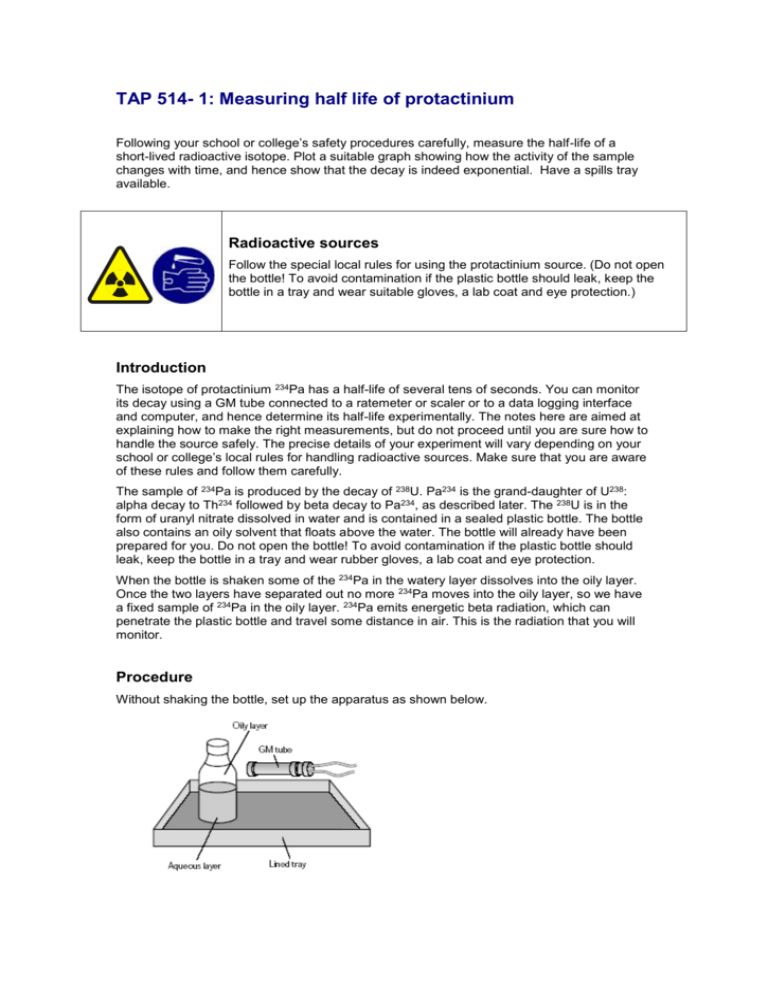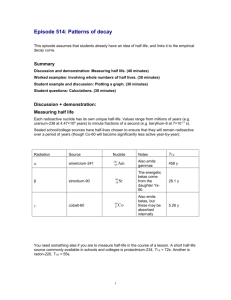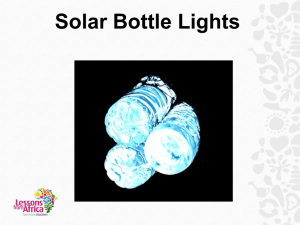TAP 514- 1: Measuring half life of protactinium
advertisement

TAP 514- 1: Measuring half life of protactinium Following your school or college’s safety procedures carefully, measure the half-life of a short-lived radioactive isotope. Plot a suitable graph showing how the activity of the sample changes with time, and hence show that the decay is indeed exponential. Have a spills tray available. Radioactive sources Follow the special local rules for using the protactinium source. (Do not open the bottle! To avoid contamination if the plastic bottle should leak, keep the bottle in a tray and wear suitable gloves, a lab coat and eye protection.) Introduction The isotope of protactinium 234Pa has a half-life of several tens of seconds. You can monitor its decay using a GM tube connected to a ratemeter or scaler or to a data logging interface and computer, and hence determine its half-life experimentally. The notes here are aimed at explaining how to make the right measurements, but do not proceed until you are sure how to handle the source safely. The precise details of your experiment will vary depending on your school or college’s local rules for handling radioactive sources. Make sure that you are aware of these rules and follow them carefully. The sample of 234Pa is produced by the decay of 238U. Pa234 is the grand-daughter of U238: alpha decay to Th234 followed by beta decay to Pa234, as described later. The 238U is in the form of uranyl nitrate dissolved in water and is contained in a sealed plastic bottle. The bottle also contains an oily solvent that floats above the water. The bottle will already have been prepared for you. Do not open the bottle! To avoid contamination if the plastic bottle should leak, keep the bottle in a tray and wear rubber gloves, a lab coat and eye protection. When the bottle is shaken some of the 234Pa in the watery layer dissolves into the oily layer. Once the two layers have separated out no more 234Pa moves into the oily layer, so we have a fixed sample of 234Pa in the oily layer. 234Pa emits energetic beta radiation, which can penetrate the plastic bottle and travel some distance in air. This is the radiation that you will monitor. Procedure Without shaking the bottle, set up the apparatus as shown below. Measure the background radiation (it comes from the bottle and the lab), counting for a suitably long period. Shake the bottle for about 30 s and place it back in position. Wait for the layers to settle and start the clock. The GM tube window should be close to the oily layer and is best mounted on a retort stand. Take readings from the GM tube as frequently as you can accurately manage until the count rate is the same as the background count. Analysis of results Subtract the effects of background radiation from your readings, and hence calculate the counts per second from the 234Pa in the oily layer. This is the corrected count rate (CCR); it corresponds to the activity of the sample. Plot a graph of corrected count rate against time and a graph of log(CCR) against time. Do your graphs correspond to what you already know about exponential decay? Use each graph to calculate the half-life of the 234Pa. (Hint: one of these involves using the gradient.) The accepted value for the half-life of 234Pa is 72 s. Discuss any disparity between your measurement and this accepted value. How great was the uncertainty in your measurement? Which of your two ways of determining T1/2 was the most reliable? What were the main causes of uncertainty in your result? How could you improve on your procedure? Practical advice This is a standard demonstration, the precise details of which will depend on the apparatus you have available. If data-logging is available, then we strongly recommend that you use it. It is vital that students correct the readings for background count. Make sure that students are clear that the half-life of an exponential decay is not exactly the same as the time constant, the latter is the time for a quantity to decay to 1/e of its initial value, not 1/2, and so the half-life is always a bit shorter than the time constant. A discussion of the units for λ and T1/2 can bring out several useful teaching points: There is an enormous range of half-lives. It is conventional to quote half-lives in whatever units are most suitable, and it would be ludicrous always to insist dogmatically on SI units (seconds) to express very long half-lives. The decay constant is usually expressed in units that tally with those used for the half-life (e.g. s-1, yr-1 as appropriate). It is vital always to quote the units of half-life or decay constant – a number on its own would be highly ambiguous. While the half-life and decay constant may have any one of several units, they always have dimensions of time and time -1, respectively. Some details of the decay may be of use and could be used to give students more experience of writing a set of decay equations. Decays by α Decay chain 238U Half Life 4.5 x 109 /years –> β 234Th –> β 234Pa –> 234U 24.1 72 2.5 x 105 /days /s /years is extracted from a solution containing the parent 234Th and ’grandparent’ 238U with which it is in equilibrium. Once extracted the decay of 234Pa can be recorded. The recovery of 234Pa can be followed in the aqueous layer if desired. 234Pa About 95% of the protactinium is removed together with some uranium when the bottle is shaken. The GM tube does not detect the alpha from the 238U or the weak beta particles (about 0.2 MeV) from the 234Th but detects only the energetic (2.32 MeV) beta radiation from the 234Pa. Technician’s notes Radioactive sources Follow the special local rules for using the protactinium source. (Do not open the bottle! To avoid contamination should the bottle leak, keep the bottle in a lined tray and wear suitable gloves, a lab coat and eye protection.) Apparatus Thin walled polythene bottle (50 cm3) containing: uranyl nitrate, 2.5 g, dissolved in 7.5ml pure water, concentrated hydrochloric acid, 17.5 ml, 25 ml of amyl acetate (pentyl ethanoate) GM tube + holder Scaler/ratemeter and stopwatch/clock or datalogger Tray lined with paper towel in case of spillage Retort stand, boss and clamp to align the GM tube with the appropriate part of the bottle Dissolve the uranyl nitrate in 7.5 ml water and add the hydrochloric acid. Then add the amyl acetate. Pour into the polythene bottle and screw the cap securely. Putting thin plastic film (e.g. cling-film) between cap and bottle can help make a better seal. Wear ‘chemical splash’ rubber gloves, a lab coat and eye protection, follow local radiation rules and dispose of any contaminated material safely. A source in a polythene bottle should not be kept for more than 12 months. Polypropylene bottles last longer. Teflon bottles (provided the wall is thin enough to let the betas through) will last 10 years. A recipe based on a 30 ml bottle is on CLEAPSS Recipe Card 57. The bottle should be labelled with the radiation symbol and also TOXIC and IRRITANT It is advisable to check the activity of the solution each year. Some teachers prefer to use fresh solution each time. Uranyl nitrate can be obtained from: TAAB Laboratory Support Limited, 3 Minerva House, Aldermaston RG7 8NA. Tel: 0118 981 7775 E-mail: _sales@taab.co.uk Prices as of September 2005: 1g for £7.99 and 25g for £69.50. External references This activity is taken from Salters Horners Advanced Physics, section RftS, Activity 9, which was an adaptation of Revised Nuffield Advanced Physics experiment F6








